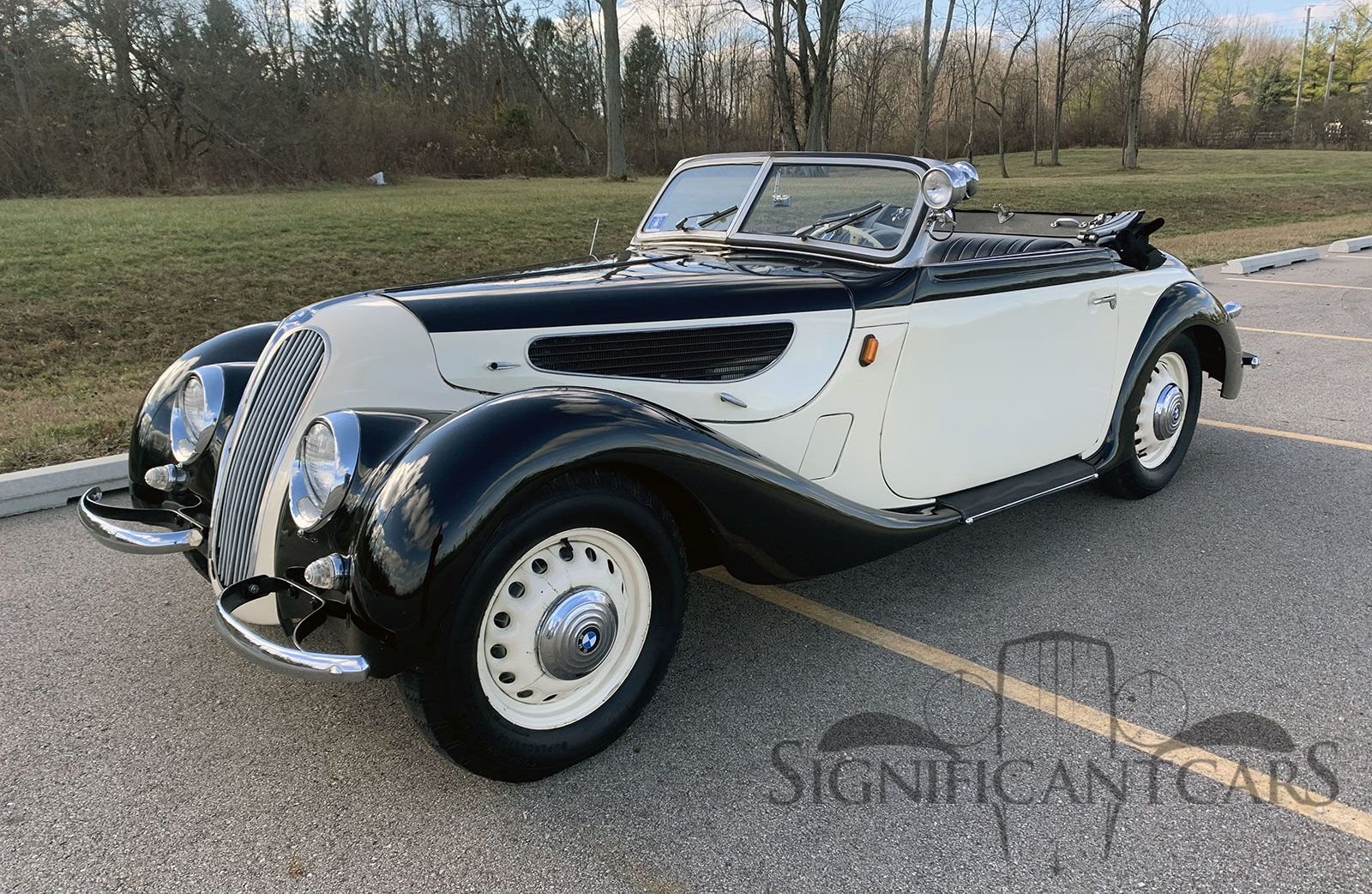Drivetrain
Chassis
Body
BMW 327 Cabriolet with BMW 503 Alloy V8 RARE FAST EXCITING
The BMW 327 is a medium-sized touring coupé produced by the Bavarian firm between 1937 and 1941, and again produced after 1945. It sat on a shortened version of the BMW 326 chassis. The first 327, launched in 1937, was a cabriolet. In 1938, this was joined by a fixed head coupé version. The car was shorter and lower than its sedan counterpart, but shared the famous BMW grill and a streamlined form representative of the more progressive designs of the 1930s. Mechanically, the car utilised the hydraulic brake control, gear box, clutch and front suspension system first seen on the BMW 326, along with the live axle used on the BMW 320 and BMW 328. The BMW M78 straight-6 engine was used. The advertised top speed was 125 km/h (78 mph).
A higher-powered model, the 327/28, was offered with the M328 engine. 569 of these high-powered 327/28 cars were built up to 1940. Among some enthusiasts, the 327 has subsequently been overshadowed by its more uncompromising sibling, the 80 bhp BMW 328 which appeared in April 1936. In its day, however, the 327 was the bigger seller, with 1,396 base engined versions built between 1937 and 1941, and significant further production after 1945.
During the 1930s, Eisenach was the centre of BMW's automobile manufacturing. In 1945, Eisenach was occupied by United States forces. However, the wartime allies had already agreed that Thuringia would fall within the Soviet occupation zone. BMW's automobile factory in Eisenach was not fully destroyed, and assembly of the 327 resumed. Clear production figures are hard to obtain, but many of the 327s surviving with collectors into the twenty-first century were post-war products. After the war, it became clear that the Soviets would not return the Eisenach factory to BMW. BMW-branded automobiles produced between 1946 and 1951 were therefore being produced outside the control of BMW headquarters in Munich. This caused a protracted dispute concerning title to the BMW brand and other assets, but in 1952 it was determined that Eisenach-produced models such as the 327s should be badged as EMW (Eisenacher Motoren Werke) rather than as BMW (Bayerische Motoren Werke). EMW changed their badge from BMW's blue and white roundel to a red and white roundel.
It is not clear how many of the post war 327s were branded as BMWs and how many as EMWs, but 505 were produced with one or other of the badges.
This exciting example was delivered on December 13, 1938 to the Michel BMW dealer in Stuttgart finished in Grey with Dark Blue Fenders, Hood, and Interior according to the BMW Mobile Tradition. Its history afterward is unclear until it was purchased in Europe in the 90's by a retired BMW Dealer out of Southern California. The car was complete but without its engine and transmission. This suited him well as he wanted to prepare the car for long distance touring on the Continent. The car was fitted with an engine and gearbox out of a BMW 503, which is far more powerful than either of the stock 6 cylinders of the 30's, and he wanted to keep up with more powerful Post War sports cars on the tours. After having his fun, he brought the car to California and eventually sold it in 2003 to our client. The car had later volvo seats installed for comfort, and a smaller Nardi Steering wheel and in the words of our client “was just tired” from all the touring it had completed. Extensive mechanical work has been performed under current ownership including having a more reliable set of weber carburators installed, although the original Solex's and air cleaner are still with the car. A correct set of 327 Seats was sourced and reupholstered in leather as well as the door cards, and other trim.
The car runs and drives extremely well, and is to be frank one of the fastest Pre-War cars I have ever driven, and I have driven some pretty powerful Pre War cars. It starts right up, runs smoothly, accelerates with a growl, and pulls strongly through the gears. I would expect this car to get to 100 MPH pretty easily, I stopped at about 70 and was only at about 2800 RPM. All the gauges and lights work properly. It handles briskly, and is an absolute joy to drive. The car presents well from 5 feet but has some cosmetic issues – pictured here- that could be addressed to take the car to the next level. Luckily most of the parts to do so are included with the car, as well as the original headlights, and some other bits. If you, however, are looking for a car to take on Tours- such as the Colorado Grand-I would leave it alone and enjoy the ride! This is a turn-key example, fully prepared for such excursions.



































































